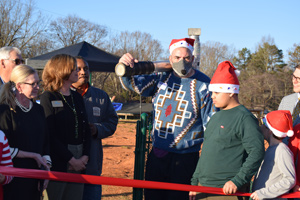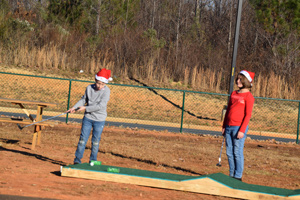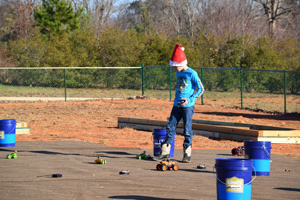Welcome!

Owner Joel Leonard (holding hammer) of Makesboro USA Mobile Makerspace. (Greta Lint / Randolph Hub)
Multi-purpose playground multi-educational, too
ASHEBORO — Uwharrie Charter Middle School officially opened its educational multi-purpose playground on Tuesday, Dec. 14. A fifth grader who helped build it, Noah Bruton, 10, and a six-grade volunteer who called herself “Helpful,” assisted Kelly Heath, president of the Asheboro/Randolph Chamber of Commerce, to cut the ribbon.
The event also launched the Makesboro USA Mobile Makerspace, owned by Joel Leonard of Asheboro.
Several months ago, the school hired Leonard to help augment the STEAM program by working with the school to build a fun, educational playground. Components gave students opportunity to learn about magnetic fields, design, electronics, technology, the Randolph County megasite, the possible Toyota jobs which might be available when the fifth graders graduate from high school, and communications while having fun.
After the ribbon-cutting, the students and guests moved to the playground.
Miniature golf course
It had a six-hole putt-putt golf course and one remote-control race car track. Built by this year’s fifth graders, it will be used by next year’s fifth graders. Several parents mentioned that this class of fifth graders will have a sense of accomplishment next year when they see the playground in use.

The students started off by grading the soil in the fall. They learned how to tie knots and used a rope to drag a cinder block, back and forth repeatedly, to level and smoothen out the playing field.
When a group of students was asked if they were having fun with the course and what they learned, they responded with an overwhelming “yes” and that they had improved their communications skills and learned about technology.
One mother said, “I have never heard of kids so excited to drag a cinder box to level land. I love that this is different.”
Another mother, Amber Sellers, said, “This gets them outside. They have already had conversation that this is a gift to the class coming up next year.”
Susan Moore, mother of Kenly Moore, 11, said, “It makes them excited about coming to school. All we have heard about is the putt-putt course and the RC track.”
The golf course had a built-in scientific challenge. Once you hit the ball, it could go either where you hit it — or be diverted suddenly away — because of a hidden magnet in the ball or under the course. It was a trick course. Students were able to learn about magnets and how they interact with each other in magnetic fields. They also designed each hole using the art and math components of the STEAM program.
Some of the golf balls had not been enhanced with a magnet. Edwin Deleon, 11, and Brylee Fink, 10, both boasted they had hit a hole in one. With the way the students had designed the courses, hitting the hole was not an easy task.
Remote car driving
The remote-control car track was designed to boost students’ communication skills and teach about the technology involved with the cars. Students were responsible for making sure the batteries were charged and positioned correctly inside the cars, that they were clean and that the track was void of debris.

of the engineer getting the remote-control car track and the cars ready for competition. This part of the new educational multi-purpose playground enabled students to learn about technology, troubleshooting and fixing things. It bolstered students’ abilities to communicate and helped them strengthen their friendships. (Greta Lint / Randolph Hub)
Students were divided into teams of two persons. One looked at the track and the other had his/her back to it and held the control unit. The student looking at the track would give directions to the other student, such as go forward, back up, turn around or go left. The student with the control unit would follow directions. However, as Hurley learned, the student facing the course needed to give reverse directions.
“Your forward is my backward,” she said to the student who was standing next to her. “Your right is my left,”
McNeill, who stands close to six feet, was working with Noah Bruton, 10, who is much shorter. Because of their height difference, they had to speak up clearly so each other could hear.
McNeill was giving the following directions to Bruton: “Right. Keep going right. Now forward. Now stop. Back up. Go left. Go straight. Go left. Go left. Go forward. You’re going to run over somebody. Stop. Go right. Left. Left. Left. Keep going left. Stop. You’re there!”
When asked what skill they both learned from the exercise, together they answered, “Communications.” Then they laughed.
Wayne Shaw, Bruton’s grandfather, was watching them interact on the remote-control course.
“I think this is great,” he said. “Not everyone is college material. We’ve made society so easy. Long ago, people didn’t have computers and did so much with so little. They used their hands and their minds.”
Trade programs
The school showcased some of its hands-on trades program, such as woodworking, blacksmithing and cosmetology.
“Fine carpentry, cabinet-making and furniture are lost arts,” carpentry and woodworking teacher Gene Anderson said. “They have not been passed down to another generation. We want to make sure we are creating teachable students. Kids will see something on YouTube or TikTok and ask if we can make that in class.”
Assistant Superintendent Chris Wheat explained that the school’s charter focuses upon STEM education. “They’re learning and don’t know it,” he said about the educational playground. “Today is a celebration of their accomplishments. It’s all about them.”
Chamber member Colleen Mitchell, with Ameriprise Financial, said when she received the text about the event, she had to come. She said there aren’t many ribbon-cuttings that involved kids. She enjoyed watching Leonard interact with the students.
“He’s a good teacher,” she said.
School Superintendent Dr. Sharon Castelli praised the project, saying the playground was “a collaboration, with the kids getting back to work with one another” after having been out of school for so long because of COVID-19.
Yes, the kids were running around being kids and swinging high in the swings. But, when the call for help rang out, they jumped to the engineering table and started work on the cars, cleaning the dirt off the battery connections and making sure the cars worked before the competition.
Issac Hussey, 10, was busy working with the cars. To him and the others, they were not just toys. They were real equipment.
“I have to get them working. Getting the batteries all charged up. I have to figure out what is wrong.”
One day, he hopes to be an electrical engineer.
He showed he is on the right path to get there.
***
Among the attendees were NC Rep. Pat Hurley and NC Rep. Allen McNeill; Sam Shumate, District Outreach Specialist for U.S. Sen. Ted Budd; Randolph County Commissioners Maxton McDowell and Hope Haywood; Linda Brown, president of the Asheboro/Randolph Chamber of Commerce, and Reynolds Lisk, former chamber board chairman; Gene Woodle, executive director of Our Daily Bread soup kitchen; Quinton Louris, director of the Small Business Center at Randolph Community College; and school administrators, STEAM (science, technology, education, art and math) teachers, and the afternoon fifth grade STEAM class, with some of the parents.
